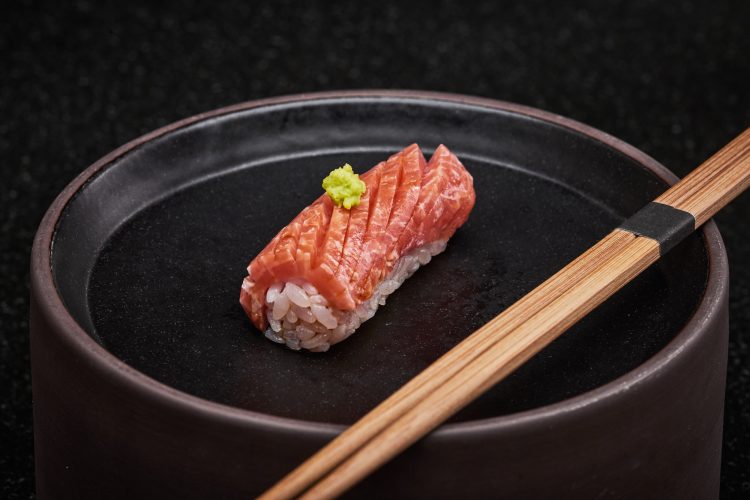Tackling overfishing with cell-cultivated fish
- Like
- Digg
- Del
- Tumblr
- VKontakte
- Buffer
- Love This
- Odnoklassniki
- Meneame
- Blogger
- Amazon
- Yahoo Mail
- Gmail
- AOL
- Newsvine
- HackerNews
- Evernote
- MySpace
- Mail.ru
- Viadeo
- Line
- Comments
- Yummly
- SMS
- Viber
- Telegram
- Subscribe
- Skype
- Facebook Messenger
- Kakao
- LiveJournal
- Yammer
- Edgar
- Fintel
- Mix
- Instapaper
- Copy Link
Posted: 18 June 2024 | Daphna Heffetz | No comments yet
Here, Daphna Heffetz outlines how alternative seafood products could mitigate the impact of overfishing, support sustainable practices, and offer nutritious options for consumers.


Image Credit: Noam Preisman
By Daphna Heffetz, Ph.D., Co-Founder and CEO of Wanda Fish
According to UN Climate Change, the ocean has borne the brunt of human-induced global warming for an extended period. As the Earth’s primary carbon sink, it absorbs surplus heat and energy stemming from the escalating emissions of greenhouse gases trapped within the planet’s atmosphere. Presently, approximately 90 percent of the heat generated by the mounting emissions has been absorbed by the ocean.
The resulting surge in oceanic temperature sets off a chain reaction of unprecedented consequences, including the thawing of ice, elevation in sea levels, occurrences of marine heatwaves, and acidification of the ocean. These transformations exert a lasting impact on marine biodiversity and the well-being of coastal communities, affecting an extensive demographic. Among those affected are approximately 680 million individuals residing in low-lying coastal regions, nearly 2 billion inhabitants of coastal megacities, around half of the global population reliant on fish as a protein source (approximately 3.3 billion people), and close to 60 million individuals employed in the industry.
Fish populations are depleting in many regions around the world due to factors such as overfishing, habitat destruction, pollution, and climate change. Overfishing, in particular, occurs when fish are caught at a rate faster than they can reproduce, leading to a decline in their numbers. This depletion not only threatens the survival of individual species but also disrupts marine ecosystems and the communities that rely on them for food and livelihoods. Conservation efforts, such as sustainable fishing practices and the establishment of marine protected areas, are crucial for addressing this issue and preserving fish populations for future generations.
One way to mitigate these risks is by providing alternative seafood products, that will relieve the pressure in the ocean. The alternative seafood market is currently small compared to meat, reflecting its still budding, innovative, and untapped growth potential. As consumer demand for sustainable options rises, this sector has a unique opportunity to expand and innovate, offering environmentally friendly alternatives to traditional seafood. Although alternative seafood products do exist, they have yet to capture the consumers, mainly due to challenges in mimicking the original and unique texture and taste of seafood products. Some of the existing products also lack the nutritional values, which is key (among many keys) to capture consumers and drive repeated purchases.
There could be two solutions to this problem:
Ceasing seafood consumption: While stopping seafood consumption might appear to be a straightforward solution, it’s not feasible due to entrenched dietary habits, cultural significance, and economic dependencies. Human nature, market demands, and livelihoods intertwined with the seafood industry render this option impractical and unsustainable.
Innovating better products: Embracing innovation offers a promising path forward. By exploring alternative sources such as plant-based, fermentation-derived, and cultivated seafood, as well as welcoming future scientific advancements, the industry can create products that rival traditional seafood in both nutritional value and sensory appeal. This approach not only addresses environmental and health concerns but also paves the way for a more sustainable and resilient food system.
Major food corporations around the world and in Asia, where demand for seafood is constantly rising, are recognising the imperative to confront the challenges posed by the seafood industry. Notably, companies in Korea, such as CJ CheilJedang, are investing in fermentation-based seafood ventures, while Shinsegae is spearheading initiatives like Better Foods. Moreover, Dongwon has ventured into the realm of plant-based canned tuna. Similarly, Japanese companies like NH and Nissin have launched plant-based tuna and eel alternatives, respectively. Maruha Nichiro is also actively engaged in this evolving field, signaling a widespread acknowledgment within the Asian food industry of the importance of embracing sustainable and innovative solutions. Other global companies are also offering plant-based seafood, such as Nestle launching three different types of fish alternatives across geographies and brands. In Europe, under the Garden Gourmet brand, Nestlé will launch marine-style crispy fillet and marine-style crispy nuggets. And last year, Wicked Kitchen acquired Current Foods, an alt-protein startup that makes plant-based sushi-grade tuna and salmon.
What role can cultivated seafood play in the alt-seafood solution?
Cultivated seafood shares similarities with traditional and plant-based seafood, albeit with a smaller market compared to meat. However, the potential for growth is significant, and the business model is conducive to its expansion. Leading the charge in this emerging field are companies like BlueNalu, Wildtype, and others, who are pioneering innovative approaches to cultivated seafood production. The cultivated seafood ecosystem is vast, with companies actively addressing key challenges such as media costs and bioreactor optimization. This presents an opportunity for seafood, as specialised media ingredients are required to tailor for seafood cell growth. Cultivated seafood also offers several advantages over wild-caught varieties, including a shorter supply chain, hygienic production conditions, reproducible and continuous supply, sustainable production practices, and the elimination of cruelty and bycatch.
Furthermore, cultivated seafood may allow for cheaper manufacturing costs, with flexibility in response to changes in temperature in the factory and oxygen levels, and the ability to grow in low-temperature environments.
And while these products are not yet available for consumers, they posses the potential of achieve the taste, texture and nutritional values so needed to drive consumer adoption.
So I am optimistic as to our future as an industry and where we, at Wanda Fish, stand. As we are leveraging patent protected innovation to make a pioneering contribution to the field of cultivated seafood by creating a cultivated rendition of the coveted Bluefin tuna Toro Sashimi. This product is created from original fish cells. Immortalised cells are differentiated into muscle fibers and accumulate fat using a non-GMO technique. As the product is to be served raw, similarly to wild-caught sashimi, Wanda Fish developed a downstream manufacturing technology to produce a whole-cut, in a manner that closely resembles traditional raw fish fillets.
For Wanda Fish, as we are developing cell-cultivated bluefin tuna, an important element is the fish’ high-fat content, which is a key contributor to taste and mouthfeel. Wanda Fish developed a fat formation technology that can control the fat content and composition thus emulating the sensory experience of wild- caught fish, preserving its nutrition, taste, texture, and mouthfeel. To the best of our knowledge, there is nothing similar to this available.
Wanda Fish’s proprietary technology allows for the growth and differentiation of the cells in one, single bioreactor making the process cost effective. Together with the whole-cut manufacturing technology, these are two key differentiators contributing to lower production cost while maintaining the quality and sensory experience of our product.
And finally, I am optimistic because Wanda Fish’s premium product has a solid business model and will not require the heavy expenditure other cultivated-food products may require.
The market is challenging and funding these days is challenging, and development is an ever-lasting effort. But for those of us who’s been operating in different markets for many years, we also know that trends come and go. Markets go up and down. Dynamics can change quickly, and innovation can make a difference. As an industry we need to learn from our mistakes and stand shoulder-to-shoulder with our peers in the alternative protein market to make our world better and tastier.
To summarise, I am optimistic we can solve the industry’s biggest challenges, together, in order to help make a better and delicious future.
About the author


Image credit: Chen Galili
Daphna has over 20 years of experience and a proven track record in establishing and growing successful biotechnology companies.
She brings extensive expertise in managing both early-stage and mature technology-based companies, including demonstrated successes in raising substantial funds and developing significant strategic partnerships.
In 2021, she co-founded and has been leading Wanda Fish which produces a whole-cut premium cultivated bluefin tuna. The company collaborates with Prof. David Kaplan, a leading cellular agriculture academic authority from Tufts University.
Daphna earned a Ph.D. in biochemistry and completed her post-doctoral fellowship in molecular biology at the Weizmann Institute of Science.








